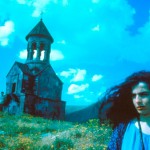In Atom Egoyan’s remarkable film Calendar (1993), a photographer and his wife (played by Egoyan and Arsinee Khanjian) travel to Armenia to take pictures of ancient churches for a calendar project. Once there, they are led through the countryside — and through the country’s historical narratives — by Ashot Adamian, an Armenian man who tells stories, sings native songs, and, eventually, vies for Khanjian’s affection. It’s a love triangle, but one with interesting metaphoric weight. Egoyan, the intellectual Westerner far-removed from his Armenian roots, is juxtaposed against Adamian, and Khanjian stands somewhere in between, torn between two symbols of her own hyphenated identity.
Khanjian is, in both a literal and metaphoric sense, the film’s translator, and the process of translation — with all of its inevitable frustrations and miscommunications — is the film’s main subject. Specifically, Egoyan is concerned with telling the stories of the Armenian diaspora, all the while knowing that culture, politics, technology, and human memory will constantly reshape and reinterpret those stories. Like Abbas Kiarostami’s Close Up, Calendar represents this dilemma even in its form, blurring the lines between documentary and narrative film, fact and fiction.
Made for German television and with a budget of only $100,000, Calendar is one of the most compelling and stylistically inventive films I’ve seen this year. Typical of Egoyan’s work, it is structured around twelve, non-linear episodes (one for each month of the calendar) and alternates between film and video footage. At times, the characters address the camera directly, their improvised dialogue lending the film some air of verisimilitude; at others, it all has a very staged feel, particularly when we watch Egoyan, now back at home in Canada, going through the rehearsed motions of dating. Calendar is quite a display of filmmaking — probably Egoyan’s best, this side of The Sweet Hereafter.
